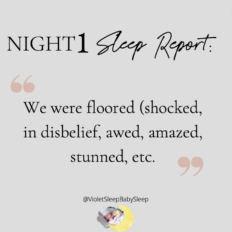If there’s one thing most parents crave during the early months and years, it’s consistency – especially when it comes to naps. A well-rested baby means a happier baby, and let’s be honest, a happier parent too! Creating the perfect baby nap routine can help bring a bit of predictability into the sometimes unpredictable world of baby sleep.
In this guide, I’ll walk you through the steps to establish a perfect baby nap routine that works for your little one, giving them the sleep they need to grow healthy and strong.
Why Having a Nap Routine Is So Important
The benefits of a perfect baby nap routine extend beyond just giving parents a break. Babies thrive on routine. Predictability gives them a sense of security and helps their little bodies know when it’s time to rest. Consistent naps contribute to better mood regulation, healthy growth, and even improved nighttime sleep.
Plus, when a baby has a dependable nap schedule, it also helps you plan your day, making life just a little bit easier. Whether it’s running errands, meeting friends, or just catching up on some much-needed rest, knowing when your baby will sleep can make a world of difference.
Steps to Create the Perfect Baby Nap Routine
Creating the perfect baby nap routine doesn’t have to be complicated, but it does require consistency and attention to your baby’s needs. Let’s break down how you can establish a routine that works for you:
1. Know Your Baby’s Sleep Needs
Every baby is unique, but there are some general guidelines to help you determine how much nap time your baby needs based on their age. Here’s a rough breakdown:
- Newborn (0-3 months): Newborns sleep around 14-17 hours a day, and naps are frequent and scattered throughout the day.
- 3-6 months: Babies this age generally need 3-4 naps per day, with total sleep of around 14-15 hours.
- 6-9 months: Two to three naps are typical at this stage, with total sleep around 14 hours.
- 9-12 months: Most babies transition to two naps, usually a morning and an afternoon nap.
- 12-18 months: By now, most toddlers settle into a single nap a day, usually in the afternoon.
Understanding how much sleep your baby needs at each stage can help you plan a perfect baby nap routine that aligns with their natural rhythms.
2. Set Consistent Nap Times
Consistency is key when establishing a nap routine. Babies are creatures of habit, and setting consistent nap times helps their internal clocks recognize when it’s time for sleep.
While some flexibility is important (life happens!), try to schedule naps at roughly the same time each day. This consistency can make falling asleep easier for your baby since their body will begin to anticipate sleep.
For example:
- Morning Nap: Between 9:00-10:00 a.m., depending on when your baby wakes up.
- Afternoon Nap: Between 1:00-2:00 p.m., to prevent them from being overtired by bedtime.
Keep in mind that the ideal schedule may vary depending on your baby’s specific age and needs, but maintaining a general structure will help create the perfect baby nap routine.
3. Create a Pre-Nap Routine
Just like bedtime, naps are a whole lot easier with a pre-nap routine to wind your baby down and signal to them it’s time for rest. A consistent pre-nap routine doesn’t have to be elaborate – it can be as simple as:
- Changing their diaper to make sure they’re comfortable.
- Reading a short story to give them some contact time with you.
- Singing a lullaby or playing gentle music to help them relax.
- Dimming the lights and creating a calm environment.
A consistent pre-nap routine helps signal to your baby that sleep is coming, which makes it easier for them to drift off and reinforces the perfect baby nap routine you’re building.
4. Watch for Sleep Cues
Your baby will often give you signs that they’re ready for a nap, and tuning into these cues is important for a successful nap routine. Common sleep cues include:
- Rubbing their eyes or pulling at their ears.
- Yawning or zoning out.
- Becoming fussy or irritable.
By recognizing these signals, you can adjust nap times as needed to avoid an overtired baby, which can make falling asleep more challenging. The key to a perfect baby nap routine is to put your baby down when they’re ready to sleep, not when they’re already past the point of exhaustion.
5. Create the Right Sleep Environment
The sleep environment plays a crucial role in helping your baby nap well. A perfect baby nap routine involves setting up a space that makes sleep easier. Here’s how:
- Keep it Dark: Use blackout curtains or shades to minimize daylight, which helps your baby understand that it’s sleep time, even during the day.
- White Noise: Consider using a white noise machine to block out household or neighborhood noises that could interrupt naps.
- Comfortable Temperature: Make sure the room is at a comfortable temperature – ideally between 68-72°F (20-22°C). If your baby is too hot or cold, it can interfere with their ability to sleep.
6. Timing Is Everything
Making sure naps aren’t too close to bedtime is important. If your baby naps too late in the afternoon, it might interfere with their ability to fall asleep at night. The perfect baby nap routine balances naps in a way that leaves enough time for play and feeding between naps, but not so much time that your baby becomes overtired.
For example, an afternoon nap that ends around 3:30-4:00 p.m. works well for a bedtime between 7:00-8:00 p.m.
7. Stick to Age-Appropriate Wake Windows
The time between sleep periods, known as a wake window, is crucial to perfecting your baby’s nap routine. Wake windows vary depending on age:
- 3-6 months: 1.5-2 hours
- 6-9 months: 2-3 hours
- 9-12 months: 3-4 hours
- 12-18 months: 4-5 hours
Paying attention to wake windows will help you make sure your baby isn’t too tired or under-tired when it’s time for their nap. This timing is a key element of creating the perfect baby nap routine.
Troubleshooting Common Nap Issues
No nap routine is without its hiccups! Here are some common challenges and how to troubleshoot them:
Baby Fighting Naps
If your baby suddenly starts fighting naps, it may be due to developmental milestones, changes in their environment, or nap timing. Make sure that your baby’s wake windows are appropriate and adjust their routine if they seem under- or overtired. P.S. Check out my blog about sleep regressions here!
Short Naps
Short naps (30-45 minutes) are very common, especially for younger babies. If your baby is waking up after a short nap, it could be because they’re unable to transition between sleep cycles. You can help by gently extending their nap routine – try staying nearby to soothe them back to sleep if they wake up early.
Skipping Naps
Sometimes babies simply refuse to nap, even when they clearly need it. This can be a sign that they’re ready to adjust their schedule. For example, they might be ready to drop from three naps to two, or their wake windows need extending. Stay flexible and remember that establishing the perfect baby nap routine is an ongoing process.
Getting the Perfect Baby Nap Routine WILL Be Worth It
Once you’ve put in the effort to establish a perfect baby nap routine, all that hard work will pay off!
- More Rest for You: Knowing when your baby will nap gives you time to recharge, catch up on tasks, or simply relax.
- A Happier Baby: Well-rested babies tend to be happier and less fussy, as naps give them the sleep they need.
- Better Nighttime Sleep: Good naps often lead to better nighttime sleep. Daytime sleep helps prevent overtiredness, which can make it harder for your baby to settle down at night.
Creating a perfect baby nap routine may take a bit of time and patience, but it’s so worth it! By understanding your baby’s sleep needs, maintaining consistency, and being attentive to their cues, you’ll be well on your way to developing a nap routine that works beautifully for both you and your baby.
And remember, if you’re struggling with getting your baby to sleep consistently or need help creating the perfect baby nap routine for your family, there is no shame in getting help! You can check out my baby sleep consulting services right here – I am always just a call or text away.




















